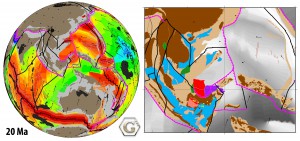 Citation
Citation
Zahirovic, S., Seton, M., and Müller, R. D., (2014). The Cretaceous and Cenozoic tectonic evolution of Southeast Asia: Solid Earth (EGU).
Summary
Tectonic reconstructions of Southeast Asia have given rise to numerous controversies that include the accretionary history of Sundaland and the enigmatic tectonic origin of the Proto South China Sea. We assimilate a diversity of geological and geophysical observations into a new regional plate model, coupled to a global model, to address these debates.
Our approach takes into account terrane suturing and accretion histories, the location of subducted slabs imaged in mantle tomography in order to constrain the evolution of regional subduction zones, as well as plausible absolute and relative plate velocities and tectonic driving mechanisms. We propose a scenario of rifting from northern Gondwana in the latest Jurassic, driven by northward slab pull from north-dipping subduction of Tethyan crust beneath Eurasia, to detach East Java, Mangkalihat, southeast Borneo and West Sulawesi blocks that collided with a Tethyan intra-oceanic subduction zone in the mid Cretaceous and subsequently accreted to the Sunda margin (i.e. southwest Borneo core) in the Late Cretaceous. In accounting for the evolution of plate boundaries, we propose that the Philippine Sea Plate originated on the periphery of Tethyan crust forming this northward conveyor. We implement a revised model for the Tethyan intra-oceanic subduction zones to reconcile convergence rates, changes in volcanism and the obduction of ophiolites. In our model the northward margin of Greater India collides with the Kohistan-Ladakh intra-oceanic arc at ~53 Ma, followed by continent-continent collision closing the Shyok and Indus-Tsangpo suture zones between ~42 and 34 Ma.
We also account for the back-arc opening of the Proto South China Sea from ~65 Ma, consistent with extension along east Asia and the formation of supra-subduction zone ophiolites presently found on the island of Mindoro. The related rifting likely detached the Semitau continental fragment from South China, which accreted to northern Borneo in the mid Eocene, to account for the Sarawak Orogeny. Rifting then re-initiated along southeast China by 37 Ma to open the South China Sea, resulting in the complete consumption of Proto South China Sea by ~17 Ma when the collision of the Dangerous Grounds and northern Palawan blocks with northern Borneo choked the subduction zone to result in the Sabah Orogeny and the obduction of ophiolites in Palawan and Mindoro. We conclude that the counterclockwise rotation of Borneo was accommodated by oroclinal bending consistent with paleomagnetic constraints, the curved lithospheric lineaments observed in gravity anomalies of the Java Sea and the curvature of the Cretaceous Natuna paleo-subduction zone. We complete our model by constructing a time-dependent network of topological plate boundaries and gridded paleo-ages of oceanic basins, allowing us to compare our plate model evolution to seismic tomography. In particular, slabs observed at depths shallower than ~1000 km beneath northern Borneo and the South China Sea are likely to be remnants of the Proto South China Sea basin.
Downloads
Download accepted manuscript with tables and figures
Download high-resolution figures
Download complete Supplementary Material, (61MB) which includes:
- GPlates plate model
- Animations
- Digitized tectonic elements (sutures, age-coded basins, ophiolites, volcanics, etc.)
Individual animations in MPEG4 and QuickTime MOV format can be downloaded below:
Plate reconstructions with plate boundaries and colour-coded blocks MP4 MOV
Plate reconstructions with plate boundaries and seafloor age-grid MP4 MOV
Plate reconstructions with plate boundaries and absolute plate velocities MP4 MOV
Regional plate reconstruction with basin histories MP4 MOV
Sunda profiles of Bouguer gravity vs. Bathymetry MP4 MOV
Sunda profiles of Bouguer vs. Free Air gravity MP4 MOV
An open-source media viewer VLC (VideoLAN) is recommended if you have problems viewing the animations. To download the individual files to your computer, you may need to right-click on the link and select “Save Link As”.
Contact
Any questions, please email: sabin.zahirovic -at- sydney.edu.au
![]()
